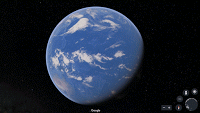The New Earth
As many of you may have seen, earlier this week Google released a major upgrade to the Google Earth app. Overall, it’s much improved, sharper, and a deeper experience for viewers. We will be upgrading/incorporating our managed fleet of Liquid Galaxies over the next two months after we’ve had a chance to fully test its functionality and polish the integration points, but here are some observations for how we see this updated app impacting the overall Liquid Galaxy experience.
Hooray! The new Earth is here! The New Earth is here! Certainly, this is exciting for us. The Google Earth app plays a key central role in the Liquid Galaxy viewing experience, so a major upgrade like this is a most welcome development. So far, the reception has been positive. We anticipate it will continue to get even better as people really sink their hands into the capabilities and mashup opportunities this browser-based Earth presents.
We tested some pre-release versions of this application, and successfully integrated them with the Liquid Galaxy and are very happy with how we are able to view-synchronize unique instances of the new Google Earth across displays with appropriate geometrically configured offsets.
What to look for in this new application:
-
Stability: The new Google Earth runs as a NaCl application in a Chrome browser. This is an enormous advance for Google Earth. As an application in Chrome it is instantly accessible to billions of new users with their established expectations. Because the new Google Earth uses Chrome the Google Earth developers will no longer need to engage in the minutiae of having to support multiple desktop operating systems, but now can instead concentrate on the core-functionality of Google Earth and leverage the enormous amount of work that the Chrome browser developers do to make Chrome a cross-platform application.
-
Smoother 3D: The (older) Google Earth sometimes has a sort of “melted ice cream” look to the 3D buildings in many situations. Often, buildings fail to fully load from certain viewpoints. From what we’re seeing so far, the 3D renderings in the New Earth appear to be a lot sharper and cleaner.
-
Browser-based possibilities: As focus turns more and more to browser-based apps, and as JavaScript libraries continue to mature, the opportunities and possibilities for how to display various data types, data visualizations, and interactions really start to multiply. We can already see this with the sort of deeper stories and knowledge cards that Google is including in the Google Earth interface. We hope to take the ball and run with it, as the Liquid Galaxy can already handle a host of different media types. We might exploit layers, smart use controls, realtime content integration from other available databases, and… okay, I’m getting ahead of myself.
The New Google Earth makes a major point of featuring stories and deeper contextual information, rather than just ogling at the terrain: as pretty as the Grand Canyon is to look at, knowing a little about the explorers, trails, and history makes it such a nicer experience to view. We’ve gone through the same evolution with the Liquid Galaxy: it used to be just a big Google Earth viewer, but we quickly realized the need for more context and usable information for a richer interaction with the viewers by combining Earth with street view, panoramic video, 3D objects, etc. It’s why we built a content management system to create presentations with scenes. We anticipate that the knowledge cards and deeper information that Google is integrating here will only strengthen that interaction.
We are looking to roll out the new Google Earth to the fleet in the next couple of months. We need to do a lot of testing and then update the Liquid Galaxies with minimal (or no) disturbance to our clients, many of whom rely on the platform as a daily sales and showcasing tool for their businesses. As always, if you have any questions, please reach us directly via email or call.
browsers google-earth visionport




Comments